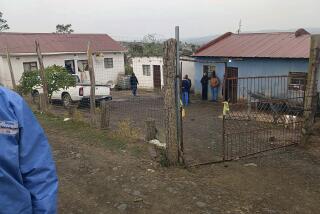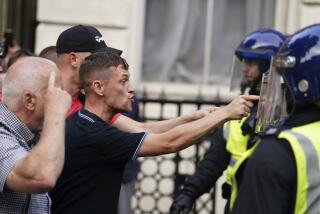Death Toll Rises in South Africa : Racial Strife Spreads to Yet Another Region
- Share via
JOHANNESBURG, South Africa — The deaths of at least eight more blacks, shot and killed by police during a weekend of fierce rioting at Queenstown, were reported by police Monday as South Africa’s civil strife spread further across the country. Leaders in the black community put the death toll at 14.
Police headquarters in Pretoria said eight blacks, as well as a ninth whose death was reported earlier, had all been fatally wounded Sunday when police fired buckshot at groups of rioters in a township outside Queenstown.
Although there had been earlier incidents, including several deaths, at Queenstown--a severely depressed farming center near East London and about 400 miles south of here--the weekend rioting appeared to mark the spread of South Africa’s civil strife into yet another region of the country, frustrating the government’s efforts to confine and curtail it.
Further incidents, among them the fatal police shooting Sunday of a 13-year-old girl at Zwelitsha near King William’s Town, were reported over the weekend and late last week in a dozen other towns in the area, which includes parts of the two Xhosa tribal homelands, Ciskei and Transkei, and the “white corridor” that runs between them north from East London to Queenstown and beyond.
Police reports put the number of deaths in the region at more than 20 in the last 10 days, and well-informed government sources speculated that the state of emergency, which gives police almost martial-law powers in a number of areas around some of South Africa’s major cities and industrial regions, might be proclaimed there shortly if the violence continues to intensify.
The Queenstown riots were touched off, according to black sources there, when police swept through the black ghetto outside the town on Friday in an apparent search for the leaders of local anti-apartheid groups, the organizers of the black boycott of white stores and youths simply regarded as troublemakers.
Black-Colored Hostility
This unrest quickly spread into neighboring Colored (mixed race) townships, and there were repeated clashes between blacks and Coloreds, who are viewed by blacks there as somewhat privileged and who, in turn, have felt threatened by the simmering unrest and the extensive black unemployment, as well.
A church, a community hall and about 20 homes were hit by firebombs in the Colored townships and heavily damaged. Police used tear gas Sunday to disperse a meeting of the Colored community called to discuss revenge against the blacks, and Colored youths stoned police several times. Five people were killed in the clashes between the blacks and Coloreds, according to community leaders in Queenstown, but police have not yet confirmed these deaths.
The worst fighting in Queenstown occurred late Sunday, according to police, when large groups of blacks, numbering from 500 to more than 1,000 at times, rampaged through the black township, stoning police and setting fire to government offices, and then, armed with gasoline bombs, started to move into Colored and nearby white areas of Queenstown.
Police, who had been using mostly tear gas and birdshot, then began using shotguns with heavy buckshot and military assault rifles to disperse the mobs. The bodies of five men were found overnight Sunday, and four others died Monday in hospitals. Eleven more blacks were reported in serious condition in hospitals with buckshot and bullet wounds.
Unrest Reported Elsewhere
Further unrest, mostly stone-throwing and firebomb attacks by roving groups of youths, was reported from Soweto, the sprawling black ghetto outside Johannesburg, and from Pretoria, East London and several smaller towns.
At Baragwanath Hospital, the 2,700-bed facility that serves Soweto, a major confrontation is expected today between the government and the medical staff, whose members are threatening to walk out in support of striking black cooks, janitors, porters and other personnel.
Local political activists have warned the medical staff members, who have been reluctant until now to join the protest, that the community expects them to show full solidarity with the support personnel.
Soldiers were brought in to replace the strikers, 800 of whom have now been fired, as well as more than 700 student nurses who walked out in support and were also dismissed.
More to Read
Sign up for Essential California
The most important California stories and recommendations in your inbox every morning.
You may occasionally receive promotional content from the Los Angeles Times.













